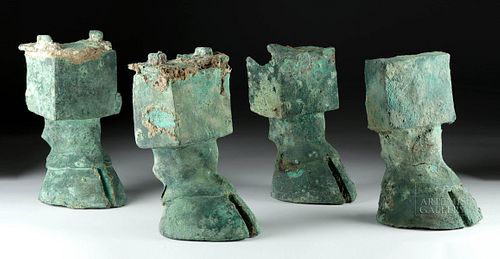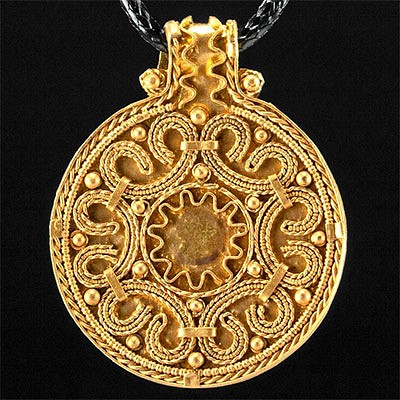Set of 4 Sabean Bronze Bull Hoof Supports
Lot 99
About Seller
Artemis Fine Arts
686 S Taylor Ave, Ste 106
Louisville, CO 80027
United States
Selling antiquities, ancient and ethnographic art online since 1993, Artemis Gallery specializes in Classical Antiquities (Egyptian, Greek, Roman, Near Eastern), Asian, Pre-Columbian, African / Tribal / Oceanographic art. Our extensive inventory includes pottery, stone, metal, wood, glass and textil...Read more
Estimate:
$13,000 - $22,500
Absentee vs Live bid
Two ways to bid:
- Leave a max absentee bid and the platform will bid on your behalf up to your maximum bid during the live auction.
- Bid live during the auction and your bids will be submitted real-time to the auctioneer.
Bid Increments
| Price | Bid Increment |
|---|---|
| $0 | $25 |
| $300 | $50 |
| $1,000 | $100 |
| $2,000 | $250 |
| $5,000 | $500 |
| $10,000 | $1,000 |
| $20,000 | $2,500 |
| $50,000 | $5,000 |
| $100,000 | $10,000 |
| $200,000 | $20,000 |
About Auction
By Artemis Fine Arts
Aug 19, 2021
Set Reminder
2021-08-19 10:00:00
2021-08-19 10:00:00
America/New_York
Bidsquare
Bidsquare : Ancient & Ethnographic Art Through The Ages
https://www.bidsquare.com/auctions/artemis-gallery/ancient-ethnographic-art-through-the-ages-7345
Ancient art from Egypt, Greece, Italy and the Near East, as well as Asian, Fossils, Pre-Columbian, Native American, African / Tribal / Oceanic, Fine art, and much more! All categories, all price ranges... all legally acquired and guaranteed to be as described or your money back. Artemis Fine Arts info@artemisfinearts.com
Ancient art from Egypt, Greece, Italy and the Near East, as well as Asian, Fossils, Pre-Columbian, Native American, African / Tribal / Oceanic, Fine art, and much more! All categories, all price ranges... all legally acquired and guaranteed to be as described or your money back. Artemis Fine Arts info@artemisfinearts.com
- Lot Description
Southern Arabian, Sabaean people, ca. 1st millennium BCE to early 1st millennium CE, probably later in the period based on the lead weight, which was a later technological innovation to stabilize monumental statuary. Four matching, more-than-life-sized cast bronze bull hooves, each capped by a large, cuboid shape, and with two have projecting slots atop the cuboid for attachment. Three are hollow on their interiors, with openings at the back of the cuboids and on the base of the foot. The fourth is filled with lead up to the interior of the cuboid form. Each stands slightly forward on its realistic hoof with two claws displayed, the cuboid slightly set over the back of the hoof rather than directly over it, with two naturalistic projections from the back, showing that the artisans who sculpted the molds to create these feet paid close attention to the details of bull anatomy. Size of each (all are relatively similar): 5.75" W x 11" H (14.6 cm x 27.9 cm)
What might these massive hooves have graced? The cuboid projections and slots on two of them suggest that they were made to hold a table or altar rather than a full statue of a bull. For example, the sandstone offering table found at Swada and now at the Louvre (AO 31930) has an animal's head on the left and feet terminating in bull's hooves. A bronze table found in 2004 in the same region is of a similar form. Another possibility is that these feet were part of a naos - a simple rectangular temple form - as in an example found near Haoulti, which had four feet shaped like bull's hooves, two pointing forward, and two pointing back, supporting a base that held a niche decorated with ornamentation. Bulls' hooves have also been found on stone furniture from the same region. Whatever these feet supported, it was a massive and important, probably ritual object.
Provenance: East Coast, USA collection from a major New York art gallery, before 2011
All items legal to buy/sell under U.S. Statute covering cultural patrimony Code 2600, CHAPTER 14, and are guaranteed to be as described or your money back.
A Certificate of Authenticity will accompany all winning bids.
PLEASE NOTE: Due to recent increases of shipments being seized by Australian & German customs (even for items with pre-UNESCO provenance), we will no longer ship most antiquities and ancient Chinese art to Australia & Germany. For categories of items that are acceptable to ship to Australia or Germany, please contact us directly or work with your local customs brokerage firm.
Display stands not described as included/custom in the item description are for photography purposes only and will not be included with the item upon shipping.
#134665All have some losses to their upper and back portions, with some slight bending to form around the opening at the back. Pale turquoise patina on surfaces of each, with encrusted deposits, especially on the tops of the pieces.Condition
- Shipping Info
-
All shipping is handled in-house for your convenience. Your invoice from Artemis Gallery will include shipping calculation instructions. If in doubt, please inquire BEFORE bidding for estimated shipping costs for individual items.
-
- Buyer's Premium



 EUR
EUR CAD
CAD AUD
AUD GBP
GBP MXN
MXN HKD
HKD CNY
CNY MYR
MYR SEK
SEK SGD
SGD CHF
CHF THB
THB

















